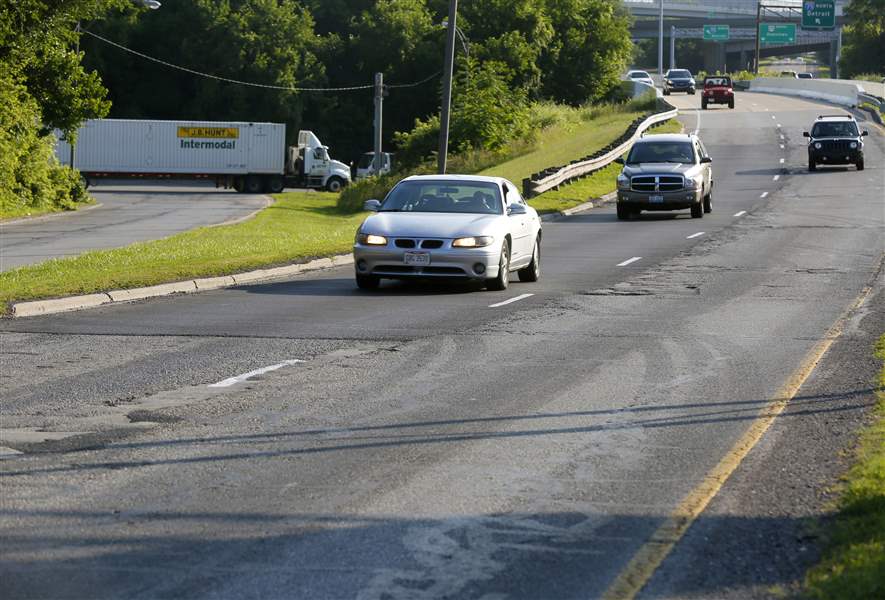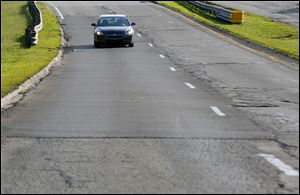
Stretches of Anthony Wayne Trail are left unfixed
Conditions improve; potholes continue to damage vehicles
7/14/2014
Traffic travels down the recently patched part of Anthony Wayne Trail, the outbound right lane just south of City Park Avenue on Thursday. Anthony Wayne Trail needs millions of dollars in work.
The Blade/Amy E. Voigt
Buy This Image

Traffic travels down the recently patched part of Anthony Wayne Trail, the outbound right lane just south of City Park Avenue on Thursday. Anthony Wayne Trail needs millions of dollars in work.
While pavement conditions have improved somewhat since the winter on the Anthony Wayne Trail, none of its tens of thousands of daily drivers should expect a fix soon for the street.
If you thought winter’s scourge of potholes and delamination would move the city to repave the busy route linking downtown with South Toledo and Maumee, think again.
RELATED CONTENT: Road Warrior: 7-14
City officials say they simply don’t have the money.
One section certain to get rebuilt within a few years is the northernmost few hundred yards, which the Ohio Department of Transportation plans to overhaul as part of an I-75 reconstruction project.
ODOT also plans to replace the Trail’s bridge over the Norfolk Southern railroad, just south of City Park Avenue.
And discussions between the city and state officials continue regarding whether a “safety project” focused on the Trail’s congested intersections with Western and South avenues can be expanded to include rebuilding the whole roadway from just south of South Avenue to the railroad bridge.
“We are in discussions with them [ODOT] to figure out how to make all that happen,” said David Dysard, a planning administrator with the city Division of Engineering Services.
But even if all those things do happen, that still leaves about four miles of six-lane boulevard between South and the Ohio Turnpike — which doubles as the Maumee city line — in need of major work.
Such reconstruction, Mr. Dysard said, has been estimated to cost just under $40 million.
This year’s total in Toledo’s capital-improvements budget for streets is just $12 million.
City officials recently applied for federal funding, through the Toledo Metropolitan Area Council of Governments, to cover 80 percent of the estimated $23.5 million cost to rebuild the Trail between South and Glendale avenues.

Traffic travels down the recently patched part of Anthony Wayne Trail, the outbound right lane just south of City Park Avenue on Thursday. Anthony Wayne Trail needs millions of dollars in work.
That application was turned down, Mr. Dysard said, but will be resubmitted for future funding, and a similar grant request — or, if necessary, requests — will be made for the $16 million section between Glendale and the turnpike bridge.
“We are going to do what we can to get this project taken care of,” he said.
In the meantime, the city patches.
In recent weeks, Toledo Division of Streets, Bridges, and Harbor crews have repaired the worst of winter’s damage, grinding away damaged pavement and paving a new surface layer in its place.
Targeted in particular were the outbound right lane between City Park and Western avenues — where the ride got so rough for drivers during winter that crews simply grounded off the top few inches of pavement and left it that way — and the inbound right lane just north of Detroit Avenue at the former location of a railroad underpass where drainage historically has been poor.
But Dave Welch, the city’s streets commissioner, acknowledges those repairs are hardly a long-term solution for the Trail.
“That’s the best we can do before we get this thing fixed properly,” he said.
How much more repair can be done on the Trail this summer, Mr. Welch said, depends on manpower.
“Once we hit July, we go into surface treatment,” he said, referring to chip-sealing of uncurbed residential streets that is best done during the warmest time of year. The streets crews that have been patching the Trail and other major arteries are the ones who do that chip-sealing job.
If building demolitions tail off, Mr. Welch said, the streets crew involved in that work could be reassigned to street repairs, but that’s an “if.”
“We’re going to continue to maintain [repair of] potholes,” the streets commissioner said, while conceding there’s more that could be done on other city streets, along with the Trail, if time and resources allow before winter’s return.
“If we have even half of what we had [for winter] last year, we’re going to have some difficulties,” Mr. Welch said.
Contact David Patch at: dpatch@theblade.com or 419-724-6094.